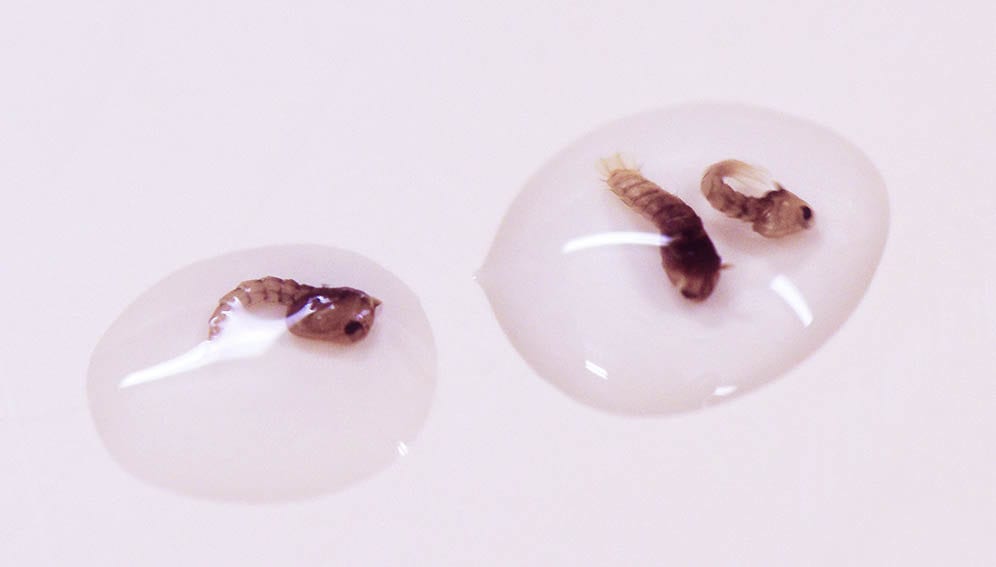30/08/19
Thyme oil and corn starch prove deadly for mosquito larvae

Send to a friend
The details you provide on this page will not be used to send unsolicited email, and will not be sold to a 3rd party. See privacy policy.
[SÃO PAULO] The mosquito-repellent properties of thyme oil have long been known. But now a team of researchers have harnessed the power of this humble herb to attack the insect’s larvae before it can spread, using another common ingredient.
By using corn starch along with the essential oil of the thyme plant, researchers from Brazil and the United States have managed to develop a low-cost, biodegradable larvicide system that can kill the larvae of the yellow fever mosquito.
The Aedes aegypti mosquito, which transmits Zika, dengue and chikungunya as well as yellow fever, lays eggs on damp surfaces and small bodies of stagnant water. These are normally found in and around the home in the form of open bottles, old tyres, uncovered water tanks and flowerpots.
The eggs can remain viable for more than a year in dry environments. However, when in contact with water, they quickly hatch and develop into larvae that become adult mosquitoes after 15 days.
“Considering that Brazil faces a serious crisis when it comes to mosquito-spread diseases, the creation of a particle that eliminates A. aegypti mosquito larvae using a raw material that is abundant, low-cost and yet biodegradable like maize starch is fantastic,”
Jamille Dombrowski, parasitologist, University of Sao Paulo
Tackling mosquitos at the larvae stage — when the insect is most vulnerable and is not yet a potential vector — is considered key to stemming their proliferation.
In order to kill a mosquito’s larvae and block its spread in water containers, researchers developed a system based on the use of essential oil as a natural larvicide. This oil is obtained from the thyme plant (Thymus vulgaris) and contains thymol, an active compound with biological activities that is widely used as a pharmaceutical and therapeutic agent.
The use of essential oils as natural larvicide is not new, but its application is often limited as they don’t dissolve well in water, degrade easily and evaporate when freely applied in the environment.
In a study published in the journal Industrial Crops & Products, researchers explain that they found a way to overcome these limitations by using a technique of microencapsulation. They used corn starch, an abundant, cheap and biodegradable raw material, to develop microcapsules as a container to release thyme essential oil into the water.
In the study, the authors say they managed to manipulate these microcapsules to modulate the oil release. In this way, while they are in a dry environment, the microcapsules remain inert and keep the thyme essential oil encapsulated.
As soon as it is exposed to water, the shell begins to swell up and release the larvicide. After three days, when the eggs hatch and the larval stage begins, the capsules release thymol (the active substance) into the water.
Ana Silvia Prata, a chemical engineer at the University of Campinas’ school of food engineering, and one of the study’s authors, said: “By doing so, we were able to obtain a capsule that behaves just like the eggs laid by A. aegypti mosquito.”
“On their first contact with water, the shells release only 20 per cent of thyme oil,” she explained. “In the tests, by letting the material dry and then rehydrating it, we discovered that the particles can still release the larvicide normally.”
This means that the microcapsules could remain functional for about five rain cycles, freeing one fifth of their content at a time.
Researchers suggested that the public sector could produce the microcapsules to hold the larvicide and then make them widely available and accessible, so that people can pour them where rainwater accumulates.“It should cost about R$30 [US$7.24] to produce a kilo of these particles,” added Prata. “We are in talks with the private sector to see if they can produce and distribute them.”
Jamille Dombrowski, a parasitologist at the Institute of Biomedical Sciences of the University of Sao Paulo, who did not take part in the study, says the findings deserve special attention from the government for several reasons.
“Considering that Brazil faces a serious crisis when it comes to mosquito-spread diseases, the creation of a particle that eliminates A. aegypti mosquito larvae using a raw material that is abundant, low-cost and yet biodegradable like maize starch is fantastic,” she told SciDev.Net.
“Added to this, thyme essential oil is a completely biodegradable material that is easily obtainable and does not represent any risk to human health.”
This article was originally produced by SciDev.Net’s Latin America and Caribbean desk.
The study published in Industrial Crops & Products was supported by FAPESP, a donor of SciDev.Net.













